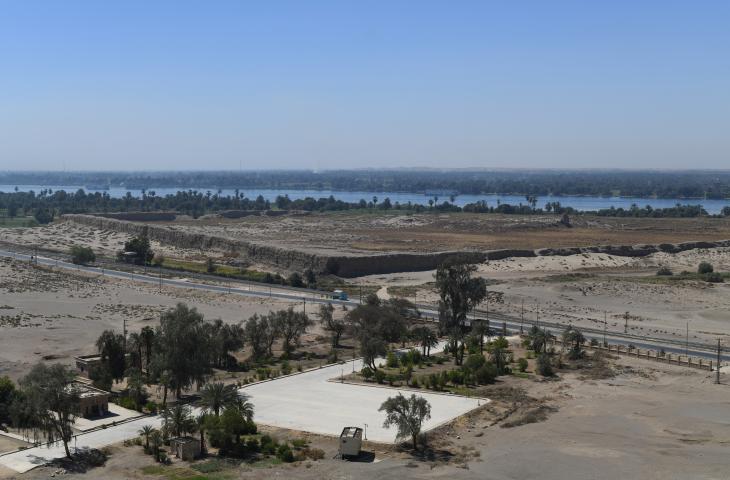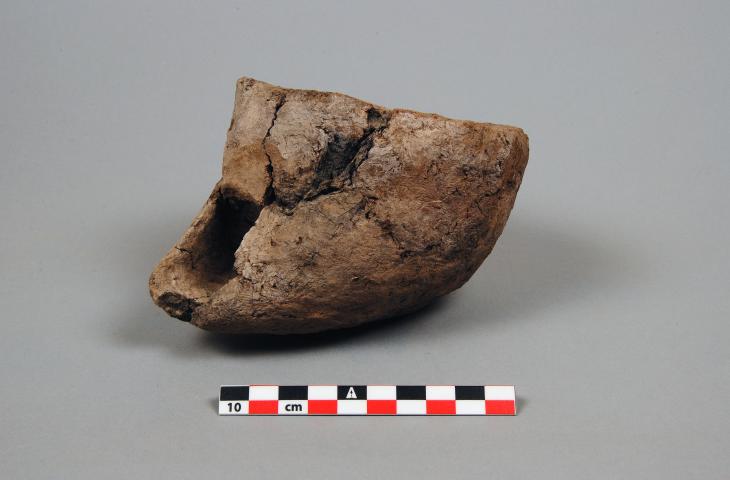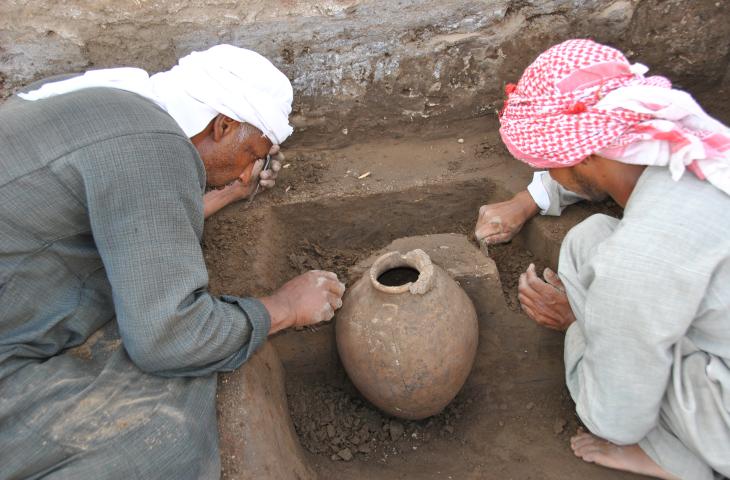Elkab

For more than 85 years, researchers of the Royal Museums of Art and History have been conducting archaeological and epigraphical research at Elkab a site located on the east bank of the Nile, some 80 km south of Luxor.
Nekheb, the ancient Egyptian name of Elkab, refers to the vulture goddess Nekhbet. She was the principal deity of Elkab and together with the cobra goddess Wadjet, the divine protectress of the pharaoh.
From a small prehistoric encampment, Elkab developed into one the first urban centres in the Nile Valley. The site stretches out over an area of several hectares and is dominated by a monumental 10 meter high mudbrick enclosure wall. Within this enclosure lie the temples of Nekhbet and Thoth which were explored by Jean Capart and his team during the very first Belgian excavations at Elkab in 1937, as well as an important part of the Elkab necropolis, which consists of a series of cemeteries from different phases of the ancient Egyptian civilization, and various other monuments. This necropolis also extends to the desert hinterland of Elkab and the impressive sandstone hill east of the enclosure wall, which is honeycombed with hundreds of rock-cut tombs. For instance, the beautifully decorated tombs of the Paheri, Reni, Ahmose and Setau, high dignitaries of the New Kingdom, are located there. Older tombs were also discovered and excavated there by the Belgian mission. They belong to the high priests of Nekhbet who were in charge of the temples at the end of the Old Kingdom (6th Dynasty). On the top of the rock necropolis also stands a monumental mastaba tomb of the 3rd Dynasty. Various other sanctuaries are located further into the desert such a rock-cut temple of the Ptolemaic period dedicated to the goddess Shesmetet, and a richly decorated New Kingdom temple constructed under pharaoh Amenhotep III an dedicated to the goddesses Hathor and Nekhbet. In between these temples also stands the Rock of the Vultures, an isolated rock covered with thousands of prehistoric petroglyphs and Old Kingdom rock inscriptions.
Over the past decades, many of these monuments have been investigated in detail by the Belgian mission, providing a wealth of information on the religious and funerary practices of the inhabitants of Elkab. Since 2009, however, the research at Elkab has shifted its attention towards the settlement area of the sites which extends over an area of about five hectares southwest of the temples of Nekhbet and Thoth. These recent excavations have revealed well-preserved habitation remains that indicate that the origins of the settlement date back to the 5th millennium BC and has since known a continuous development until the Coptic period. The excavated remains of houses, pottery, stone tools, faunal material and other objects paint a fascinating and varied picture of the organization of daily life at Elkab. The discovery of exotic materials such as obsidian originating from Ethiopia also indicates that the site was part of an international network for the supply of precious raw materials over very long distances. The discovery of an intact crucible for copper production dating to the 2nd Dynasty (ca. 2900 BC)—the oldest complete specimen ever found in Egypt— also underlines the role Elkab must have played in the development and spread of metal production in ancient Egypt.
As such, the importance of the recent excavations at Elkab cannot be underestimated. After all, our knowledge of Egyptian civilisation is still largely based on information drawn from richly decorated tombs and temples and still far too little from the settlements themselves. The recent research carried out by the Royal Museums of Art and History in Elkab therefore contributes substantially in closing an important research gap with regard to our knowledge of ancient Egypt.
Partners
Royal Museums of Art and History
Universiteit Gent – Departement geografie
American University in Cairo – Department of Sociology, Egyptology and Anthropology
Universität zu Köln – Institut für Prähistorische Archäologie
Sponsors
Belspo (Research project MO/38/020; 2009–2010)
Yale University Egyptology Endowwment Fund (2012)
Gerda Henkel Stiftung (Research projects A20/F/14; 2015 – 2016, A57/F/18; 2019–2023)
National Geographic Society (Research project GEFNE173-16)
Huis van Horus
Recent publications
- Claes, W., 2020. The settlement of Elkab. Nekhen News 31: 18–19.
- Claes, W.; Davey, C. & Hendrickx, S., 2019. An Early Dynastic crucible from the settlement of Elkab. Journal of Egyptian Archaeology 105(1): 29–42.
- Claes, W. & Hendrickx, S., 2021. The lost tell of Elkab [in:] Buchez, N. & Tristant, Y. (éds.), Égypte antérieure : Mélanges de préhistoire et d’archéologie offerts à Béatrix Midant-Reynes par ses étudiants, collègues et amis (Orientalia Lovaniensia Analecta 304). Leuven: Peeters: 189–212.
- Claes, W.; Hendrickx, S.; Devillers, A.; Hart, E.; Kindermann, K.; De Dapper, M.; Ikram, S.; Storms, G.; Swerts, C. & D. Huyge, 2014. From the early Old Kingdom to the Badarian. Preliminary report on the 2012 excavation campaign in the settlement area of Elkab [in:] Mączyńska, A. (ed.), The Nile Delta as a Centre of Cultural Interactions between Upper Egypt and the Southern Levant in the 4th Millennium BC (Studies in African Archaeology 13), Poznań: Poznań Archaeological Museum: 73–93.
- Claes, W.; Hendrickx, S. & Hart, E., 2023. Pits, pots and silos: Storage facilities at the Predynastic and early pharaonic settlement of Elkab [in:] Bats, A. & Lictra, N. (eds.), Storage in Ancient Egypt: Earthen Architecture and Building Techniques. Leiden: Sidestone press: 55–68.
- Claes, W. & Huyge, D., 2016, Finds from Elkab: Revealing the origins of the settlement, Egyptian Archaeology 49: 38–42.
- Claes, W. & Huyge, D., 2017. De nederzetting van Elkab: Op zoek naar de oorsprong van de urbanisatie in het oude Egypte. Science Connection 55: 44–48.
- Claes, W. & Huyge, D., 2017. La zone d’habitat d’Elkab : À la recherche des origines de l’urbanisation en Égypte ancienne. Science Connection 55: 44–48.
- Claes, W.; Vanhulle, D. & De Putter, T., 2021. Obsidian in early Egypt: The provenance of a new fragment from the Predynastic settlement at Elkab and the question of possible exchange routes [in:] Claes, W.; De Meyer, M.; Eyckerman, M. & Huyge, D. (eds.), Remove that Pyramid! Studies on the Archaeology and History of Predynastic and Pharaonic Egypt in Honour of Stan Hendrickx (Orientalia Lovaniensia Analecta 305). Leuven: Peeters: 187–236.
- De Meyer, M.; Claes, W.; Mahran, N.M.A.; Van der Perre, A. & Gräzer Ohara, A., 2023. Working with Capart: Quftis and local workmen during the Elkab excavation seasons, 1937–1946 [in:] Navratilova, H.; Gertzen, T.L.; De Meyer, M.; Dodson, A. & Bednarski, A. (eds), Addressing Diversity: Inclusive Histories of Egyptology (Investigatio Orientis 9). Münster: Zaphon: 339–360.
- Depraetere, D.; Devillers, A.; De Dapper, M. & Claes, W., 2021. An enigmatic subterranean building within the Great Walls at Elkab [in:] Claes, W.; De Meyer, M.; Eyckerman, M. & Huyge, D. (eds.), Remove that Pyramid! Studies on the Archaeology and History of Predynastic and Pharaonic Egypt in Honour of Stan Hendrickx (Orientalia Lovaniensia Analecta 305). Leuven: Peeters: 364–388.
- Hendrickx, S.; Claes, W.; Devillers, A.; Storms, G.; Swerts, C. & Vereecken, S., 2016. The Pottery from the Late Early Dynastic and Early Old Kingdom Settlement at Elkab (Excavation Season 2010) [in:] Bader, B.; Knoblauch, C.M. & Köhler, E.C. (eds), Vienna 2 – Ancient Egyptian Ceramics in the 21st Century (Orientalia Lovaniensia Analecta 245). Leuven: Peeters: 259–276.
- Huyge, D., 2012. Urbanisme anno 2600 v.Chr. Belgische archeologische missie ontdekt stad uit het Oude Rijk in Egypte. Science Connection 37: 3–7.
- Huyge, D., 2012. Urbanisme en l’an 2600 av. J.-C. Une mission archéologique belge découvre une ville de l’Ancien Empire en Égypte. Science Connection 37: 3–7.
- Huyge, D., 2013. Death and life in Old Kingdom Elkab. Ancient Egypt 76: 28–37.
- Huyge, D., 2017. King Sahure in Elkab. Egyptian Archaeology 50: 41–43.
- Huyge, D. & Limme, L., 2012. Elkab après Capart : Du campement préhistorique à la ville gréco-romaine [in:] Bavay, L.; Bruwier, M.-C.; Claes, W. & De Strooper, I. (éds), Ceci n’est pas une pyramide ... Un siècle de recherche archéologique belge en Égypte. Leuven: Peeters : 46–59.
- Huyge, D. & Limme, L., 2012. Elkab na Capart: Van prehistorische kampeerplaats tot Grieks-Romeinse nederzetting [in:] Bavay, L.; Bruwier, M.-C.; Claes, W. & De Strooper, I. (eds.), Ceci n’est pas une pyramide ... Een eeuw Belgisch archeologisch onderzoek in Egypte. Leuven: Peeters: 46–59.
- Kindermann, K., 2021. Predynastic Elkab: A first stoney perspective [in:] Claes, W.; De Meyer, M.; Eyckerman, M. & Huyge, D. (eds.), Remove that Pyramid! Studies on the Archaeology and History of Predynastic and Pharaonic Egypt in Honour of Stan Hendrickx (Orientalia Lovaniensia Analecta 305). Leuven: Peeters: 661–679.
- Marchand, S., 2021. « Entre deux murs… » : Note sur quelques tessons et terres cuites remarquables d’Elkab du IVe siècle av. J.-C. [in:] Claes, W.; De Meyer, M.; Eyckerman, M. & Huyge, D. (eds.), Remove that Pyramid! Studies on the Archaeology and History of Predynastic and Pharaonic Egypt in Honour of Stan Hendrickx (Orientalia Lovaniensia Analecta 305). Leuven: Peeters: 809–827.
- Rowland, J., Maříková Vlčková, P., Hendrickx, S., Herbich, T., Claes, W. & Huyge, D., 2009. Old Kingdom settlement remains at Elkab (Upper Egypt): Preliminary report on the 2009 field season. Bulletin van de Koninklijke Musea voor Kunst en Geschiedenis / Bulletin des Musées royaux d’Art et d’Histoire 80: 21–50.
- Vanhulle, D. & Claes, W., 2024. Boat models from the Early Dynastic settlement of Elkab: New insights on the archaeology of early pharaonic domestic contexts [in:] Tristant, Y.; Villaeys, J. & Ryan, E.M. (eds.), Egypt at its Origins 7: Proceedings of the Seventh International Conference “Origin of the State. Predynastic and Early Dynastic Egypt”, Paris, 18th–23rd September 2022 (Orientalia Lovaniensia Analecta 323). Leuven: Peeters: 717–740.



